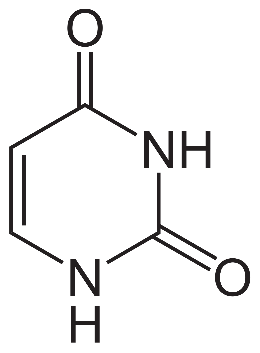Select Question Set:
Identify the molecule shown in the figure:

1.
Uracil
2.
Thymine
3.
Cytosine
4.
Guanine
Subtopic: Nucleic Acid: Nucleotides |
76%
From NCERT
Please attempt this question first.
Hints
Please attempt this question first.
If we represent the chemical composition of living tissue from abundance point of view, the most abundant chemical in living organisms is:
| 1. | Water | 2. | Carbohydrates |
| 3. | Proteins | 4. | Lipids |
Subtopic: Element Analysis |
86%
From NCERT
Please attempt this question first.
Hints
Please attempt this question first.
Identify the incorrect statement:
| 1. | Each protein is a polymer of amino acids. |
| 2. | A protein is a heteropolymer and not a homopolymer. |
| 3. | Essential amino acids can be synthesized in our body. |
| 4. | Collagen is the most abundant protein in animal world. |
Subtopic: Proteins |
87%
From NCERT
Please attempt this question first.
Hints
Please attempt this question first.
Which end of the glycogen molecule is the reducing end?
1. The left
2. The right
3. The right and the left both
4. Neither the right nor the left
1. The left
2. The right
3. The right and the left both
4. Neither the right nor the left
Subtopic: Carbohydrates: Starch & Glycogen |
80%
From NCERT
Please attempt this question first.
Hints
Please attempt this question first.
Identify the correct statements:
1. Only a and b
2. Only a and c
3. Only b and c
4. Only c and d
| a: | Plant cell walls are made of cellulose. |
| b: | Fungal cell walls are made of chitin. |
| c: | True bacterial cell walls are made of lipopolysaccharides. |
| d: | Archaeal cell walls are made of sporopollenin. |
2. Only a and c
3. Only b and c
4. Only c and d
Subtopic: Carbohydrates |
93%
From NCERT
Please attempt this question first.
Hints
Please attempt this question first.
Nucleic Acids:
1. Only I is correct
2. Only II is correct
3. Both I and II are correct
4. Both I and II are incorrect
| I: | are polynucleotides. |
| II: | are constituents of the true macromolecular fraction of any living tissue or cell. |
2. Only II is correct
3. Both I and II are correct
4. Both I and II are incorrect
Subtopic: Nucleic Acid |
86%
From NCERT
Please attempt this question first.
Hints
Please attempt this question first.
Regarding the primary structure of a protein:
1. Only I and II are correct
2. Only I and III are correct
3. Only II and III are correct
4. I, II and III are correct
| I: | The sequence of amino acids i.e., the positional information in a protein is called the primary structure of a protein. |
| II: | A protein is imagined as a line, the left end represented by the first amino acid and the right end represented by the last amino acid. |
| III: | The first amino acid is also called as C-terminal amino acid and the last amino acid is called the N-terminal amino acid. |
2. Only I and III are correct
3. Only II and III are correct
4. I, II and III are correct
Subtopic: Structural Organisation of Proteins |
75%
From NCERT
Please attempt this question first.
Hints
Please attempt this question first.
Adult human haemoglobin consists of:
I: 4 subunits.
II: 4 types of subunits.
1. Only I is correct
2. Only II is correct
3. Both I and II are correct
4. Both I and II are incorrect
I: 4 subunits.
II: 4 types of subunits.
1. Only I is correct
2. Only II is correct
3. Both I and II are correct
4. Both I and II are incorrect
Subtopic: Structural Organisation of Proteins |
86%
From NCERT
Please attempt this question first.
Hints
Please attempt this question first.
In a polypeptide or a protein, amino acids are linked by a peptide bond which is formed:
1. Only I
2. Only II
3. Both I and II
4. Neither I nor II
| I: | when the carboxyl (-COOH) group of one amino acid reacts with the amino (-NH2) group of the next amino acid |
| II: | with the elimination of a water moiety (the process is called dehydration) |
2. Only II
3. Both I and II
4. Neither I nor II
Subtopic: Zwitter ion & Peptide Bond |
88%
From NCERT
Please attempt this question first.
Hints
Please attempt this question first.
The direction of a phosphodiester bond [in a polynucleotide chain] is:
| 1. | 5’ – 3’ | 2. | 3’ – 5’ |
| 3. | 1’ – 3’ | 4. | 3’ – 1’ |
Subtopic: Nucleic Acid |
52%
From NCERT
Please attempt this question first.
Hints
Please attempt this question first.
Select Question Set:
